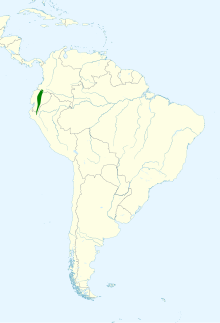| Plain-tailed wren | |
|---|---|

| |
| Conservation status | |
 Least Concern (IUCN 3.1) | |
| Scientific classification | |
| Domain: | Eukaryota |
| Kingdom: | Animalia |
| Phylum: | Chordata |
| Class: | Aves |
| Order: | Passeriformes |
| Family: | Troglodytidae |
| Genus: | Pheugopedius |
| Species: | P. euophrys |
| Binomial name | |
| Pheugopedius euophrys (PL Sclater, 1860) | |

| |
| Range of plain-tailed wren year-round | |
| Synonyms | |
|
Thryothorus euophrys | |
The plain-tailed wren (Pheugopedius euophrys) is a species of songbird in the family Troglodytidae. It has a mostly rufous body with a gray, black, and white striped head. It is found in the Andes of southern Colombia, Ecuador, and northern Peru. Its natural habitat is subtropical or tropical moist montane forests. Plain-tailed wrens are so-called bamboo specialists and live almost exclusively in chusquea bamboo thickets. Like other wrens, its diet consists mainly of insects with some seeds and berries.
Taxonomy
The plain-tailed wren belongs to the order Passeriformes and the family Troglodytidae. Three subspecies are recognised:
- P. e. euophrys (Sclater, PL, 1860) – southwest Colombia and west Ecuador
- P. e. longipes (Allen, JA, 1889) – central east Ecuador
- P. e. atriceps Chapman, 1924 – north Peru north of the Río Marañón
The grey-browed wren was formerly considered as a subspecies but is now treated as a separate species based on the distinctive vocalizations and some morphological differences.
Description

Physical
The plain-tailed wren has an unflattened wing of 64–71 mm and weighs from 20 to 36 g. The back, wings, and tail are rufous, with an olive cast on the back. The belly and other underparts are buffy-gray, and the head is gray with black and white stripes (superciliary, malar, and submalar stripes). The bill is gray and slightly decurved. The plain-tailed is large for a wren, but shows the characteristic short tail shared by the family. As the name suggests, it is unique among wrens because its tail lacks any barring.
Plain-tailed wrens on the western slope of the Andes tend to have heavy black spotting on the breast, while eastern-slope birds show no such markings.
Vocalizations
The plain-tailed wren sings a rolling, repetitive song. Singing pairs of plain-tailed wrens coordinate such that the duets between males and females alternate syllables so quickly it sounds as if a single bird is singing. Research finds the brains of both birds process the entire duet, not just each bird's own contribution. Groups of males and females also in groups of up to seven individuals chorus in synchrony. Each bird has a repertoire of roughly 20 phrases, and they, in synchrony, select the same type at the same time as others of their sex. Songs can last up to 2 min, during which individuals join in and drop out. Two-part antiphonal choruses usually take an ABCD form, where the male contributes the A and C phrases and the female sings during B and D. Group choruses are thought to be used in mutual territory defense to intimidate intruding individuals.
Distribution and habitat
The plain-tailed wren prefers chusquea bamboo thickets in tropical moist montane forests. It also frequents recently disturbed areas, such as fresh landslides, presumably because of the increase in insect activity. It is most commonly found at elevations between 2200 and 3200 metres. It is found mainly in Ecuador, but its range extends into southern Colombia and northern Peru. The plain-tailed wren is listed as a species of least concern. It is common within its range.
Behavior
Diet
The plain-tailed wren is mainly insectivorous, like most other wrens. Its diet can include seeds and berries, but these are not its primary food source. The bird is most often observed foraging on or near the ground in chusquea bamboo undergrowth, in search of invertebrates.
Breeding
Plain-tailed wrens are thought to use song duetting as a form of bonding and/or mate guarding. No other information regarding mating systems or nesting behavior was found.
References
- BirdLife International (2016). "Pheugopedius euophrys". IUCN Red List of Threatened Species. 2016: e.T103888269A94292836. doi:10.2305/IUCN.UK.2016-3.RLTS.T103888269A94292836.en. Retrieved 17 November 2021.
- Ridgely, Robert S.; Greenfield, Paul J. (2001). The Birds of Ecuador: Field guide. Ithaca, NY: Cornell University Press. ISBN 0-8014-8721-8.
- Greeney, Harold F.; Boesman, Peter F. D.; Spencer, Andrew J.; Kroodsma, Donald E.; Brewer, David (2023-06-16). "Plain-tailed Wren (Pheugopedius euophrys)". Birds of the World. Cornell Lab of Ornithology. doi:10.2173/bow.pltwre1.02.
- ^ Gill, Frank; Donsker, David; Rasmussen, Pamela, eds. (August 2024). "Dapple-throats, sugarbirds, fairy-bluebirds, kinglets, hyliotas, wrens & gnatcatchers". IOC World Bird List Version 14.2. International Ornithologists' Union. Retrieved 15 October 2024.
- Freeman, Benjamin G.; Montgomery, Graham A. (2017). "Using song playback experiments to measure species recognition between geographically isolated populations: A comparison with acoustic trait analyses". The Auk. 134 (4): 857–870. doi:10.1642/AUK-17-63.1.
- Parker, T.A.; O'Neill, J.P. (1985). "A new species and a new subspecies of Thryothorus wren from Peru". Ornithological Monographs. 36: 9-15 . doi:10.2307/40168273. JSTOR 40168273.
- Fortune, Eric S.; Rodríguez, Carlos; Li, David; Ball, Gregory F.; Coleman, Melissa J. (2011-11-04). "Neural Mechanisms for the Coordination of Duet Singing in Wrens". Science. 334 (6056): 666–670. doi:10.1126/science.1209867. ISSN 0036-8075.
- ^ Mann, Nigel I; Dingess, Kimberly A; Slater, P.J.B (2006-03-22). "Antiphonal four-part synchronized chorusing in a Neotropical wren". Biology Letters. 2 (1): 1–4. doi:10.1098/rsbl.2005.0373. ISSN 1744-9561. PMC 1617190. PMID 17148310.
External links
- song audio: https://macaulaylibrary.org/asset/83163
| Taxon identifiers | |
|---|---|
| Pheugopedius euophrys | |
| Thryothorus euophrys | |